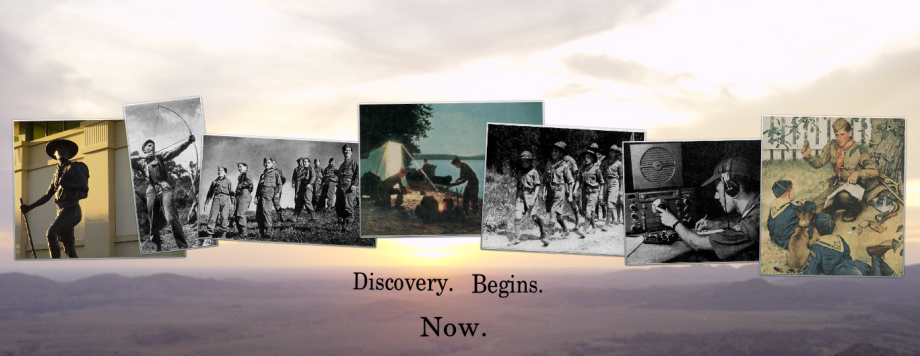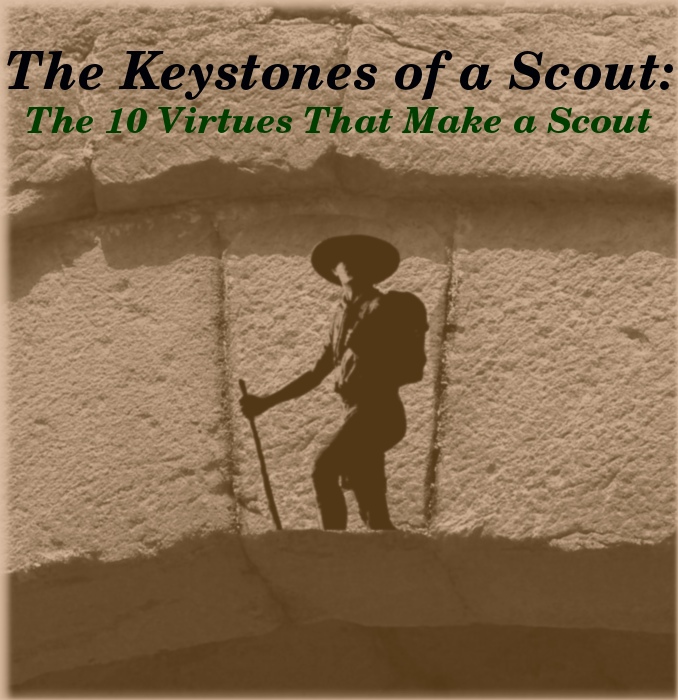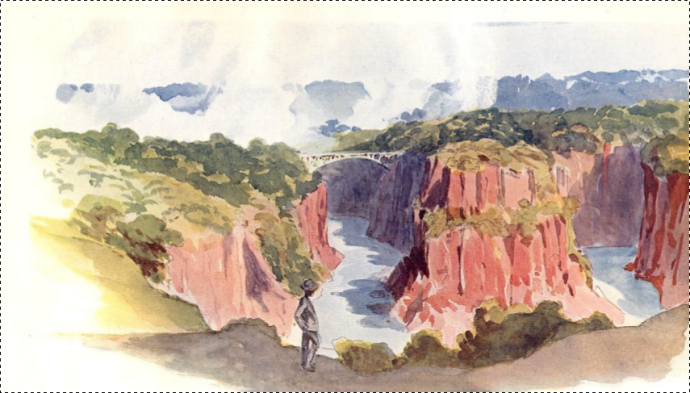“To meet their spirit of adventure I held up for their ideal the doings of backwoodsmen and knights, adventurers and explorers, as the heroes for them to follow.” ~ Baden-Powell
I have particularly enjoyed doing the research for this third installment of the Keystones of a Scout series: Exploration.
“Very few fellows learn these things when they are living in civilized places, because they have comfortable houses, and soft beds to sleep in. Their food is prepared for them, and when they want to know the way, they just ask a policeman.
Well, when those fellows try to go scouting or exploring, they find themselves quite helpless. Take even your sports “hero” and put him down in the wilderness, alongside a fellow trained in camping, and see which can look after himself. High batting averages are not much good to him there. He is only a “tenderfoot”.” ~ Baden-Powell
 You don’t need to dig far into the history of Scouting to see how much pioneers, adventurers, and explorers have influenced the Scouting movement. This is perhaps the real reason that most of us joined the Scouting movement, is it not? Scouting promised us adventure. Scouting promised us camping trips, canoe trips, hiking, rafting. Scouting promised us the exploration of the wilderness.
You don’t need to dig far into the history of Scouting to see how much pioneers, adventurers, and explorers have influenced the Scouting movement. This is perhaps the real reason that most of us joined the Scouting movement, is it not? Scouting promised us adventure. Scouting promised us camping trips, canoe trips, hiking, rafting. Scouting promised us the exploration of the wilderness.
We all have that inner desire to explore, to seek out new lands and discover new things. That has been, and always will be, the chief appeal of Scouting. The very word itself means that: Scouting. We want to Scout out new things and explore uncharted territories.
Early Scouting writings are full of stories about wilderness explorers, pioneers, backwoodsmen, and hunters. Sadly, however, the days of the pioneer are gone, in America at least. There are no more ‘cowboys’ as there once was. There are no more Lewis and Clark’s, no more Daniel Boone’s.
So where does that leave Exploration now? Does the extinction of the backwoodsman leave Exploration, and therefore a key aspect of Scouting, outdated?
 Of course not! As long as there are frontiers, there will be Exploration. As long as there is Exploration, Scouts will pursue it. The question is: where are the frontiers? The answer is that they are all around us. No, we don’t have a continent of unexplored land, but nevertheless there still frontiers in almost every field you can think of.
Of course not! As long as there are frontiers, there will be Exploration. As long as there is Exploration, Scouts will pursue it. The question is: where are the frontiers? The answer is that they are all around us. No, we don’t have a continent of unexplored land, but nevertheless there still frontiers in almost every field you can think of.
On August 6, 2012 (seven days ago as I’m writing this), a U.S. Mars Rover, dubbed the Curiosity, landed on the surface of Mars and sent back it’s first pictures of the surface of Mars. If you want an uncharted physical wilderness to explore, technology has made the whole solar system this wilderness. But it doesn’t stop there.
Exploration is more than just visiting strange, new lands. Exploration is a concept that can be applied to any field where there are things that haven’t been done before, and that leaves just about every field a frontier. In Science, in Art, in History, etc., etc.; I could go on down the list.
That means that this world still needs the Scout. This world still needs the Scouting movement. Exploration is embedded into the fabric of Scouting. That is why I picked Exploration as one of the 10 Scout Keystones. If you are a true Scout, you will be an explorer.
Exploration in Merit Badges
In the Scouting organization of the B.S.A., there are many opportunities to help us Scouts get started in exploration. Let’s start with the Merit Badges. John Thurman, an influential British Scouter, said this of Merit Badges:
“These badges are not just tests, they are invitations to explore. If you read them in the right spirit they all say: ‘Come and have a shot at this.’ Don’t let us think in terms of ‘Passing badges’, but think of the badges as something that will lead us into new fields and new experiences.”
In my personal experience, this is too often not the case. We go about earning Merit Badges like checking things off a list. The more we can get done, the better. Often, we go to a Merit Badge class, sit through a school-like lecture for two hours, do a few activities, fill out some paper-work, and, voilà!, we have the Merit Badge.
It wasn’t in this spirit that Merit Badges were designed! They are opportunities for exploration! When we earn a Merit Badge, we should have more than a ‘Cliff notes’ summary of the topic. We should have a thorough working knowledge of the topic and a desire to pursue it further.
This is partly what Scouting Rediscovered is about. Let’s rediscover the Merit Badge as it was intended: a real ‘Badge of Merit’. There are exciting things to discover in each Merit Badge topic, they are opportunities of Exploration.
Exploration as a Way of Life
Merit Badges are just one example of a way us Scouts can fulfill our duty to Explore. There are many others. Too often in the virtue of Exploration, Scouting has failed to be Scouting any more. As Scouts, we should not be satisfied with walking the beaten path in any area. From Camps and Hiking trips, to service projects and virtues, we should try to push beyond what has been done before and explore the boundaries of what is conventional and common-place.
This goes back to what Scouting really is. The B.S.A., for example, is Scouting, but Scouting itself is not the B.S.A. or any organization; it is a way of life. That is why we say ‘once an Eagle, always an Eagle’. The Principles of Scouting that you learned to become an Eagle Scout, including Exploration, will stay with you for the rest of your life whether or not you remain active in a local Troop.
Conclusion
 So in summary, a Scout and an explorer are one and the same. A true Scout has the spirit of Exploration inside of him. He’s not a miner for gold or glory, he explores for the sake of Exploration. He aspires to and does things that are considered impossible, then he comes back and tells the world, “Look! See what you can achieve. This is possible!” He explores things that he does not know and maps them for others to follow.
So in summary, a Scout and an explorer are one and the same. A true Scout has the spirit of Exploration inside of him. He’s not a miner for gold or glory, he explores for the sake of Exploration. He aspires to and does things that are considered impossible, then he comes back and tells the world, “Look! See what you can achieve. This is possible!” He explores things that he does not know and maps them for others to follow.
Well, thanks for reading this rather long post. Do you have any comments, thoughts, or questions? I’d love to hear them! What do you like exploring?
I want this to get out to as many Scouts as possible, so please help by sharing this post. You can easily share this on Facebook, Twitter, and etc. by clicking the little icons below this post.
If you don’t want to miss the rest of the installments of this series, just put your email in the little box to the right on the home page, and you will automatically get an email each time a new post is published.
Thanks again! Scout on, my friends!
“Something hidden. Go and find it. Go and look behind the Ranges – Something lost behind the Ranges. Lost and waiting for you. Go!”
~ Rudyard Kipling




Pingback: Keystones of a Scout: The 10 Virtues That Make a Scout | Deduction | Scouting Rediscovered
Pingback: Keystones of a Scout: The 10 Virtues That Make a Scout | Initiative « Scouting Rediscovered
Pingback: Keystones of a Scout: The 10 Virtues That Make a Scout | Ingenuity « Scouting Rediscovered
Pingback: Keystones of a Scout: The 10 Virtues that Make a Scout | Chivalry « Scouting Rediscovered